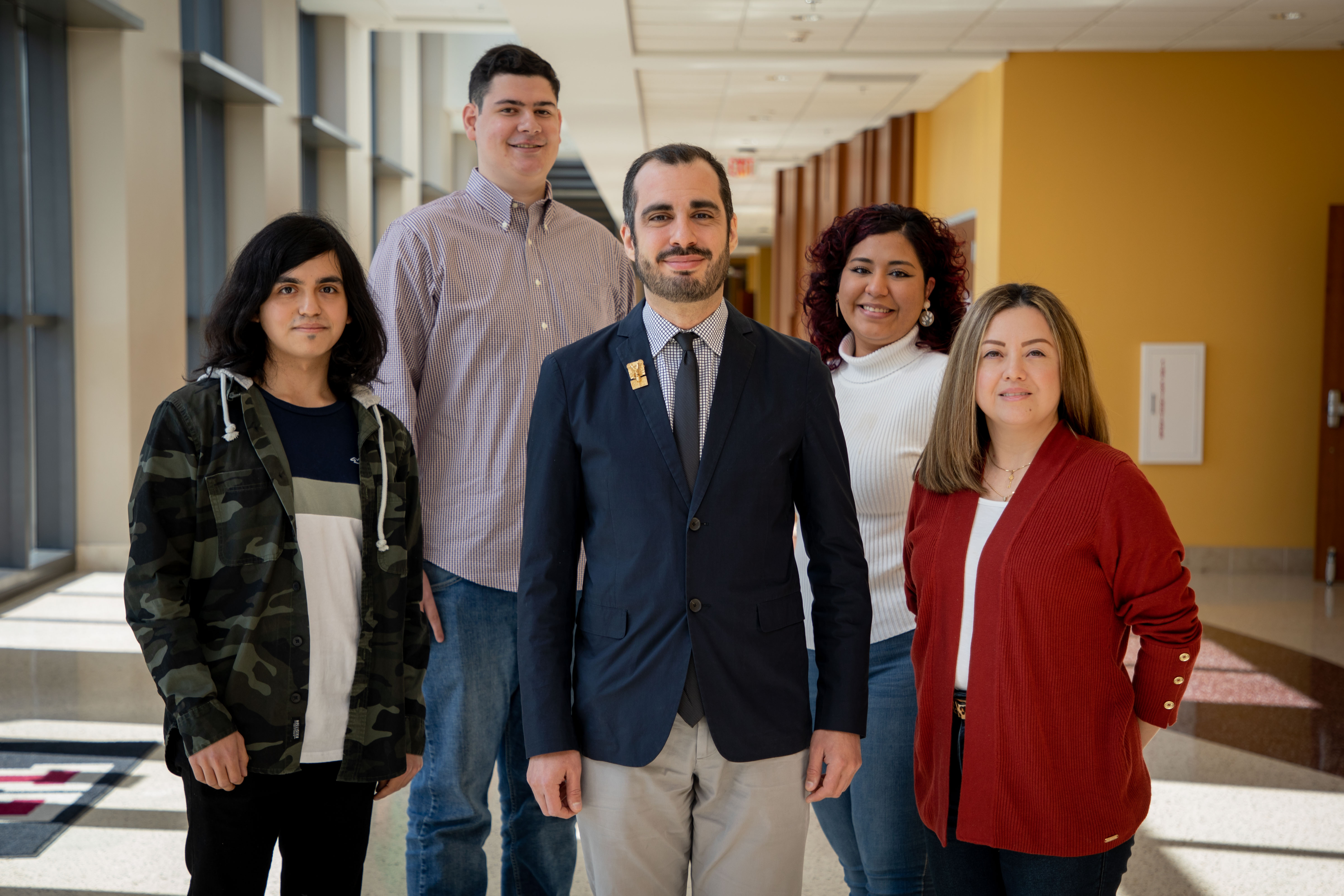TAMIU Students Embark on Paleography Project on Mexico’s Indigenous People

Four budding researchers and students at Texas A&M International University (TAMIU) recently learned about Spanish colonial paleography as part of a course taught by Dr. Aaron Olivas, associate professor of History.
Throughout the Fall 2021 semester, students Yara Chapa, Juan Flores González, Gerardo Muñoz, and Mariana Ponce were initially given a choice of either writing a traditional research paper or learning Spanish colonial paleography to submit a manuscript transcription on the Indigenous people of México, primarily the Zapotec people of Oaxaca.
The students decided to take on learning paleography and become better researchers and historians, affirmed Olivas.
“The option of learning paleography is a unique opportunity for TAMIU students to acquire advanced research skills used by professional historians in the field who work closely with unpublished manuscripts written in pre-modern handwriting and pre-modern forms of language. Original manuscripts are the gold standard as far as sources for historical research are concerned. Many TAMIU students already know modern Spanish, so it is efficient for them to pick up and practice this skill using digital sources from Mexican archives,” Dr. Olivas explained.
The documents transcribed by the students were a bill of sale from Santo Domingo Etla (1693), a testament from San Pedro el Alto (1711), a bill of sale from Santo Domingo Etla (1715) and a testament from San Pedro el Alto (1764).
The transcriptions were then added to the Ticha Project, an NEH- and ACLS-funded online digital text explorer for Colonial Zapotec history (https://ticha.haverford.edu/en/). Once added to the working database, the transcriptions can later be interpreted by Zapotec speakers for scholarly purposes, Olivas noted.
“This digitization has been greatly facilitated by Ticha in ways unthinkable to scholars and wider community members in the past. This semester our focus was manuscripts relevant to Indigenous communities of Oaxaca—in particular Zapotecs—found in the collections of the Archivo Histórico Municipal de la Ciudad de Oaxaca, Archivo Histórico de Notarias del Estado de Oaxaca, Archivo General del Poder Ejecutivo del Estado de Oaxaca, Mexico City’s Archivo General de la Nación. From these collections, we deciphered 17th- and 18th-Century legal cases, testaments, and bills of sale produced by (and about) Indigenous Oaxacans themselves in both Spanish and Zapotec languages,” said Olivas.
By learning these different methodologies, Olivas acknowledges the multifaceted work needed to understand and preserve the history of Mexico’s Indigenous peoples.
“It helps students become aware of the complex training, knowledge, and effort necessary to work on the history of Colonial México—and most especially México’s Indigenous history. Likewise, unpublished manuscripts are often understudied or neglected given limitations such as access and the difficulty of reading them. That means by learning paleography, students this semester unlocked potentially new perspectives about Mexican history found in these rare documents,” said Olivas.
For Flores, a Psychology major who wanted to take a course with Dr. Olivas, the opportunity to learn more about México’s Indigenous culture helped her to realize a goal.
“I did this project to learn more about the origins of Indigenous languages in México. Since I was born in México and I enjoy my culture, I realized that it was time to give back to my community and I found that by doing this project I could accomplish this goal,” said Flores.
Ponce, a History major, affirmed her interest in the semester’s paleography project.
“This semester with the paleography assignment, I learned a lot about Mexican culture and reading Mexican documents in Spanish and Zapotec. What was fascinating about it was learning how to read these historic documents,” said Ponce.
The transcribed documents recognize the ways Zapotecs survived colonialism through resistance to authority, linguistic and cultural adaptation, and the negotiated use of Hispanic legal customs to protect themselves, their property, and their traditions.
Olivas first became aware of the Ticha Project through a colleague and friend, Dr. Xóchitl Flores-Marcial, a Zapotec ethnohistorian and community member who serves on the project’s advisory board. He then met the project’s leader, Dr. Brook Lillehaugen, in Oaxaca while traveling there through a TAMIU University Travel Grant and conducting research at the Archivo Histórico Municipal de Oaxaca, Archivo Histórico de Notarías de Oaxaca, and the Biblioteca Fray Francisco de Burgoa.
By learning more about the Zapotec people and their contribution to the world, historians have found evidence suggesting they were the first large-scale urban dwellers of the Americas and among the earliest developers of domesticated corn and the science behind the culinary process of nixtamalization—both of which are crucial for the creation of Mexican dietary staples such as tortillas and tamales, noted Olivas.
Additionally, the Zapotec people were among the first literate peoples of the Americas and—as evident in archival manuscripts and even contemporary social media—they have never ceased writing, Olivas said.
“This long history of ingenuity, continuity, and adaptation underscores the importance of studying Zapotec language and culture. It also reminds us of the need to collectively support Zapotec community members in preserving this knowledge in the face of the modern pressures of migration, globalization, and racism that often lead to social or political demands for ‘assimilation’ through denial of their identity and heritage. In the best of all possible worlds, historians working with Zapotec documents should use their scholarly pursuits to foster such equity. Certainly, the contributions of our TAMIU students to the Ticha Project are important steps in that direction,” affirmed Olivas.
For more information on the paleography and the Ticha Project, contact Dr. Olivas via email at aaron.olivas@tamiu.edu.
To read TAMIU’s 2021 Annual Report or access a downloadable PDF file, go to: https://www.tamiu.edu/annualreport/
To preview the Spring Semester at TAMIU, visit: https://go.tamiu.edu/springpreview
Spring Semester face to face classes begin Monday, Jan. 24. Late Registration continues through Jan. 28, 2022. To learn more about TAMIU’s Registration processes, visit the dedicated Registration Hub at https://go.tamiu.edu/registration.

Pictured, from left to right, are Gerardo Muñoz, Juan Flores González, Dr. Aaron Olivas, Mariana Ponce and Yara Chapa.



